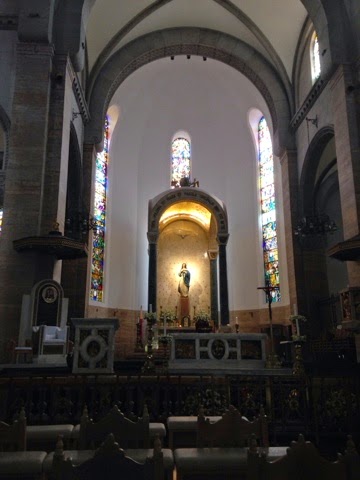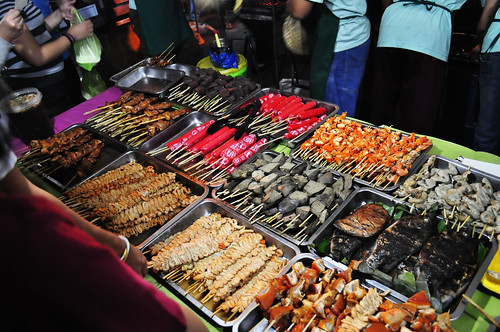Salamat Po!
 |
| War Memorial |
Dates of Travel: 4th - 8th February 2015
I jumped at the opportunity when G had to travel to Manila, Philippines, for work. I've wanted to visit Manila for quite some time as some of my colleagues are Filipinos and the talk of their home just got me really curious. Also took this opportunity to visit some of my ex-colleagues!
I really have to apologize for the bad quality photos. I actually packed my camera chargers, accessories, etc etc, and I
forgot to bring the camera itself. I only realized I left my camera on the dining table at home when I was on the plane to Manila. All the photos were taken using my iPhone 5. *insert sad face*
(Note: I'm just gonna start clearing my backlog of posts that I'm supposed to write, but got too lazy..)
Manila American Cemetery & Memorial
Address: Taguig City, Manila, Metro Manila, Philippines
The Manila American Cemetery and Memorial in the Philippines occupies 152 acres on a prominent plateau, visible at a distance from the east, south and west. It contains the largest number of graves of our military dead of World War II, a total of 17,201, most of whom lost their lives in operations in New Guinea and the Philippines. The headstones are aligned in 11 plots forming a generally circular pattern, set among masses of a wide variety of tropical trees and shrubbery.
 |
| War Memorial |
It is sincerely one of the most beautiful cemetery/memorial I've ever visited (not that I've been to a lot, but I've been to my fair share of cemeteries and memorial parks). It was a bright and beautiful day when we arrived. Bus loads of students were lined up at the bus bay and throngs of Filipinos were unloading their cars with snacks and children.
 |
| students roaming the grounds |
Despite the sun shining brightly, the wind was cool and we just wandered around aimlessly. Reading all the poems and messages engraved on the marble walls made me quite emotional. It brought back memories of movies like Pearl Harbour, Saving Private Ryan and other war movies. So many sons, brothers, husbands, and fathers lost due to the war.
There were marble pillars and columns after columns of which perished soldiers names were engraved on. It was such a shock to the system as there were SO MANY names, and I knew this was only just a handful, a small picture to what war is like.
Rizal Park
 |
| Rizal Monument |
Rizal Park (Filipino: Liwasang Rizal) also known as Luneta Park or colloquially Luneta, is a historical urban park located along Roxas Boulevard, City of Manila, Philippines, adjacent to the old walled city of Intramuros. Since the Spanish Colonial Era, Being one of the largest urban park in Asia, It has been a favourite leisure spot, and is frequented on Sundays and national holidays. It is one of the major tourist attractions of the City of Manila.
Situated by Manila Bay, Luneta is also an important site in Philippine history. The execution of national hero José Rizal on December 30, 1896, fanned the flames of the 1896 Philippine Revolution against the Kingdom of Spain. The area was officially renamed Rizal Park in his honor, and the monument enshrining his remains serves as the park's symbolic focal point. The Declaration of Philippine Independence from the American Occupation was held here on July 4, 1946 as were later political rallies including those of Ferdinand Marcos and Corazon Aquino in 1986 that culminated in the EDSA Revolution.
It is basically just an open air park with benches and a monument. If you visit without the history knowledge of the park, you'd just dismiss it as just another park to have a picnic. As you can see in the
blurry picture above, the flags on the right are Philippines and on the left is Indonesia. We asked a guide on why Indonesia's flag was up and they said that foreign ministers who visit Manila are usually brought to Rizal Park to pay their respects and the respective country's flag will be flown for that few days together with the Filipino flag.
Intramuros
 |
| Intramuros |
Intramuros (Latin, "within the walls") is the oldest district and historic core of Manila, the capital of the Philippines. Also called the Walled City, it was the original city of Manila and was the seat of government when the Philippines was a component realm of the Spanish Empire. Districts beyond the walls were referred as the extramuros of Manila, meaning "outside the walls".
Construction of the defensive walls was started by Spanish colonial government in the late 16th century to protect the city from foreign invasions. The 0.67-square-kilometre (0.26 sq mi) walled city was originally located along the shores of the Manila Bay, south of the entrance to Pasig River. Guarding the old city is Fort Santiago, its citadel located at the mouth of the river. Land reclamations during the early 20th-century subsequently obscured the walls and fort from the bay.
Intramuros was heavily damaged during the battle to recapture the city from the Japanese Imperial Army during the Second World War. Reconstruction of the walls was started in 1951 when Intramuros was declared a National Historical Monument, which is continued to this day by the Intramuros Administration (IA). The Global Heritage Fund identified Intramuros as one of the 12 worldwide sites "on the verge" of irreparable loss and destruction on its 2010 report titled Saving Our Vanishing Heritage, citing its insufficient management and development pressures.
What stark difference it was once you stepped past the thick stone walls into Intramuros. I felt like I time traveled into the past! Intramuros is so huge that there are a few schools and universities located inside Intramuros. There used to be seven churches, but five were destroyed during the Japanese Occupation.
 |
| snacking on dried mangoes |
Despite it being the same day as when we visited the Manila American Cemetery and Memorial, the heat was unbearable! It would have been lovely to just wander around the grounds and a really incredible place for photos, but my skin was burning from the sun rays and we were sweating buckets. I think the closed up stone walls played a part in scorching us. We were basically dodging from museum to museum to art galleries. We saw some Filipino families having picnics on the grass and I really have utmost respect for them. Unless the weather is like San Francisco's (
office workers come out and play frisbee in office wear during their lunch), there's no way you'd see me sitting in the sun enjoying a picnic.
Manila Cathedral
 |
| inside the cathedral |
The Manila Metropolitan Cathedral-Basilica (Filipino: Metropolitanong Katedral Basílika ng Maynilà; Spanish: Catedral Basílica Metropolitana de Manila), informally known as Manila Cathedral, is a Roman Catholic basilica located in Manila, Philippines, dedicated to the Blessed Virgin Mary as Our Lady of the Immaculate Conception, the Principal Patroness of the Philippines. The cathedral serves as the see of the Archbishop of Manila, the de facto Primate of the Philippines.
Located at Plaza de Roma in the Intramuros district of the City of Manila, the cathedral was originally a parish church owned and governed by the Archdiocese of Mexico in 1571, until it became a separate diocese on 6 February 1579 upon the issuance of the papal bull, Illius Fulti Praesido by Pope Gregory XIII. The cathedral was damaged and destroyed several times since the original structure was built in 1581 while the eighth and current incarnation of the cathedral was finally completed in 1958.
 |
| beautiful stained glass |
We wandered into the cathedral as the shade looked so inviting. Having studied in a Catholic school for 11 years, I could appreciate all the beautiful statues of Mother Mary & Jesus. The stained glass is a work of art. Not only does it provide shade from the glaring heat and rays outside, it adds a nice touch to the whole ambiance. I spent a good twenty minutes just walking around and looking at all the stained glass windows.
 |
| stained glass windows |
Each window depicts a different story in the Bible. One window would be about Mother Mary spreading the gospel, another is about the Holy Spirit.
Fort Bonifacio High Street
 |
| gah, so grainy |
Bonifacio High Street is a shopping mall in Bonifacio Global City, Metro Manila, Philippines located just near Serendra, Market! Market! and SM Aura. It is owned by Ayala Malls, a real-estate subsidiary of Ayala Land, which is an affiliate of Ayala Corporation. It opened in the 2007 and it is one of Ayala Corporation's flagship projects. The mall offers a mix of high-end retail shops, restaurants, amenities, leisure and entertainment in the Philippines. Currently, the mall has four sections, the first and second blocks are an open-air shopping, while the third block is a mixture of open-air and indoor commercial buildings dubbed as the Bonifacio High Street Central and the fourth block which was named Bonifacio High Street South or simply High Street South in which is a mixture of open-air and indoor commercial-residential buildings.
 |
| Thanks Ritzelle! |
Many international brands are located at High Street. However, those brands there are what we could find in Singapore, we didn't shop much. We did visit lots of cupcake and dessert shops though! The whole area of Fort Bonifacio felt very safe (as compared to other parts of Manila) as there are a lot of police officers patrolling the area with police dogs, riffles or just patrolling in their cars. You could actually see people jogging or walking their dogs along the streets at night which is a very uncommon sight in Manila.
Abe Restaurant
Address: Mcarthur Avenue, Bonifacio Global, Taguig, 1630 Metro Manila, Philippines
Phone: +63 2 856 0526
Website:
http://ljcrestaurants.com.ph/abe/
 |
| Klassik Kare Kare |
Klassik Kare Kare - Traditional tender oxtail stew cooked with tripe and vegetables in a creamy, rich peanut-base sauce
Chicharong bulaklak - Deep fried pork intestines with special garlic sauce.
 |
| Abe's Knockout Knuckles |
Abe's Knockout Knuckles - Need I say more? Crispy pork knuckles!
 |
| Binukadkad na Crispy Pla-Pla |
Binukadkad na Crispy Pla-Pla - Large tilapia, butterflied and fried to crispy tenderness.
Banchetto at A Venue Makati
 |
| street BBQ Food |
I'm sorry I had to use other people's photos. I was too engrossed in eating and ordering food and gawking at a whole piglet roasting over charcoals before my very eyes that I forgot to take photos. And when I remembered, it was so dark my photos turned out like crap.
 |
| Thanks Rose! |
So, Banchetto is like a huge
Pasar Malam of sorts selling a lot of local street food. They had stuff like sisig, chicken intestines (still prefer pork though), pork knuckles, adobo, BBQ seafood skewers, you name it. The whole atmosphere was so lively and.. oily. I LOVE IT! There's even a live band playing.
 |
| sausages and roasted pork |
 |
| chicken intestines |























No comments:
Post a Comment